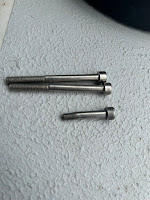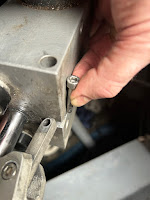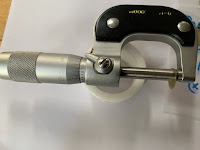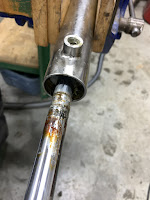On paper, the hydraulically-operated centreboard and rudder are a clever, well-engineered system, and its 2-section Hydroem manual pump is a jewel. Unfortunately, if the 435 has a weakness in real-world use, it might be this system. While it might tolerate a sympathetic and mechanically aware owner who understands and maintains it, it will punish neglect.
The system is prone to corrosion, particularly the rudder cylinder's shaft, especially if the rudder is left down for extended periods and not cycled. It should be kept in the raised position when not in use. It can be incredibly difficult to remove the close-fitting stainless steel pin that secures the hydraulic cylinder in the aluminum centreboard trunk. I strongly recommend freeing and lubricating this pin every 2 years or so. (An awkward job) Sakura's issue with centreboard operation mentioned above was a result of the system not having been correctly purged of air. The owner should understand the principles of how the system operates and how to bleed the system. The cylinders themselves are somewhat specialized and typical industrial hydrauliccs houses may not be comfortable servicing them. It is telling that more recent Alubat models use a mechanical system instead of hydraulics.
How to replace the Centreboard Cylinder
This is detailed in a seperate post.Bleeding the system.
Earlier Posts
Hydraulic Cylinders
I've had an interesting experience with cylinders. (Some context: The boat in the Caribbean, and I am in Toronto. I was doing the refit during periodic vacation weeks, months apart)There appears to be something dimensionally different about the tolerances in these cylinders vs those commonly used in industry. Until this is understood I would only order from Alubat/Hydroem unless the boat, owner, and hydraulics shop are all local so that issues can be quickly resolved. Why are they different, and what is the specification?
2-section pump
Pump Fuses
‘Pastille’ (losenge) in French, ‘fuse’ in English, this sacrificial disc is located in the pump and ruptures in the event of a locked centreboard (or rudder) encountering an immovable object, hopefully prevcnting damage to all involved.
Many have suggested that DIY fuses are fine in this application, some are more cautious. I thought I’d investigate….
The beer can is made of .007" aluminum, punch is 1/2” in diameter.
Original Posts
Update - April 2023
As noted below, I was able to free up and disassemble the rudder cylinder. Though I was prepared to replace with new, I figured I’d bring it to a local hydraulics shop for assessment. It needs a new shaft and seals of course - estimate is C$300-500. Much better than €1300 plus shipping, taxes etc. normally such things go the other way.
The pump was stiff, and the rudder cylinder nearly seized. The centreboard would raise but not lower with hydraulic pressure. Definitely not hardware store items, and clearly suffering from age and neglect. I’ll offend other owners if I call it an OVNI weak point, but it’s definitely a talking point for most.
Hydroem 2-section Pump
Here’s a link to my January 2023 attempt to operate the pump.
https://m.youtube.com/watch?v=gES-mjiD7vU
When I returned in March I lubricated the pump and it began to work freely. I inspected the copper ‘pastilles’ and they were intact, so the centreboard issue lies elsewhere.
Hydroem Rudder Cylinder
On my initial inspection, the rudder would not operate with pump pressure and would only budge (slightly) if the rudder were moved by hand. With some cycling, it eventually ended up gushing hydraulic fluid from around a corroded cylinder shaft.
In my return in March I commenced work on the rudder (documented elsewhere) and managed to excavate and remove the cylinder.
It was quickly condemned by a very helpful Erik at hydrostore in Curacao as it could barely be moved and not disassembled. I brought it home with me.
Hydroem, the manufacturer in La Rochelle France, quoted €1300 for a replacement.
Somewhat curious, I sprayed a liberal amount of PB blaster inside, and let it sit for two days. (Old engine trick…)
Though stiff, it could now be moved more easily, and with some crisp hammer taps I managed to slowly get it extended, then apart. Much to surprise, while the shaft is destroyed, the rest looks pretty good.
Notes on Hoses
The exact hose that i have in Nella (2006 – 435) is Synflex 3031-02 1/8″ . It was made by Saint Gobain in 2003.
Saint Gobain was taken over by Eaton (USA) in 2006 which is also owns the Danfoss brand–its still being made and its measured in inches.
The internal diameter is nominally 1/8″ but more accurately 0.130 inch
External diameter is 0.340 inch
Hose is available from Eurohydraulics (https://www.eurohydraulicsscotland.com/) –they are super responsive and friendly and expect a shipment of 3031-02 to arrive in about 6 weeks
Its also available from the Hydrasun (https://hydralink.hydrasun.com/PublicCatalogue/Page.aspx?i=11001) catalog. But at present they don’t have any in stock and its going to take “about 6 weeks” if ordered.



















No comments:
Post a Comment